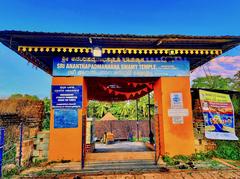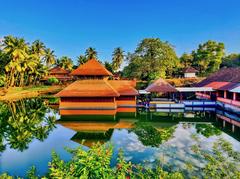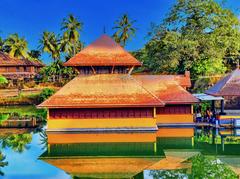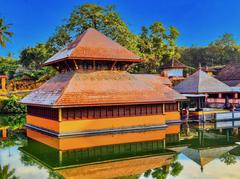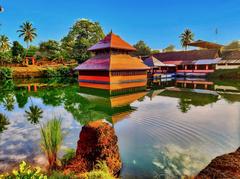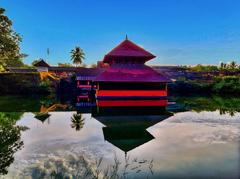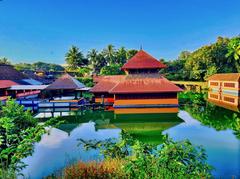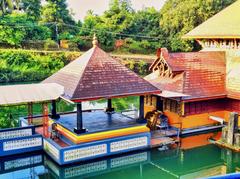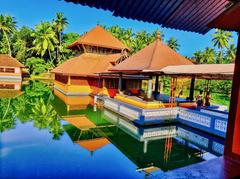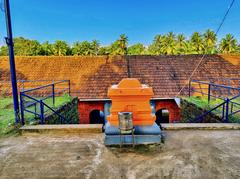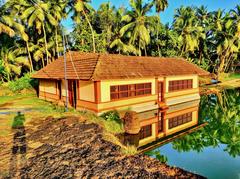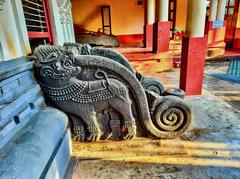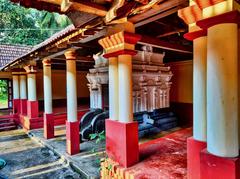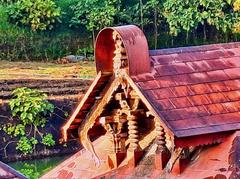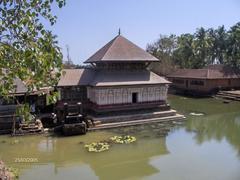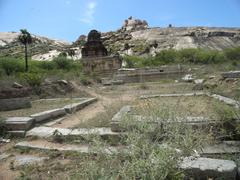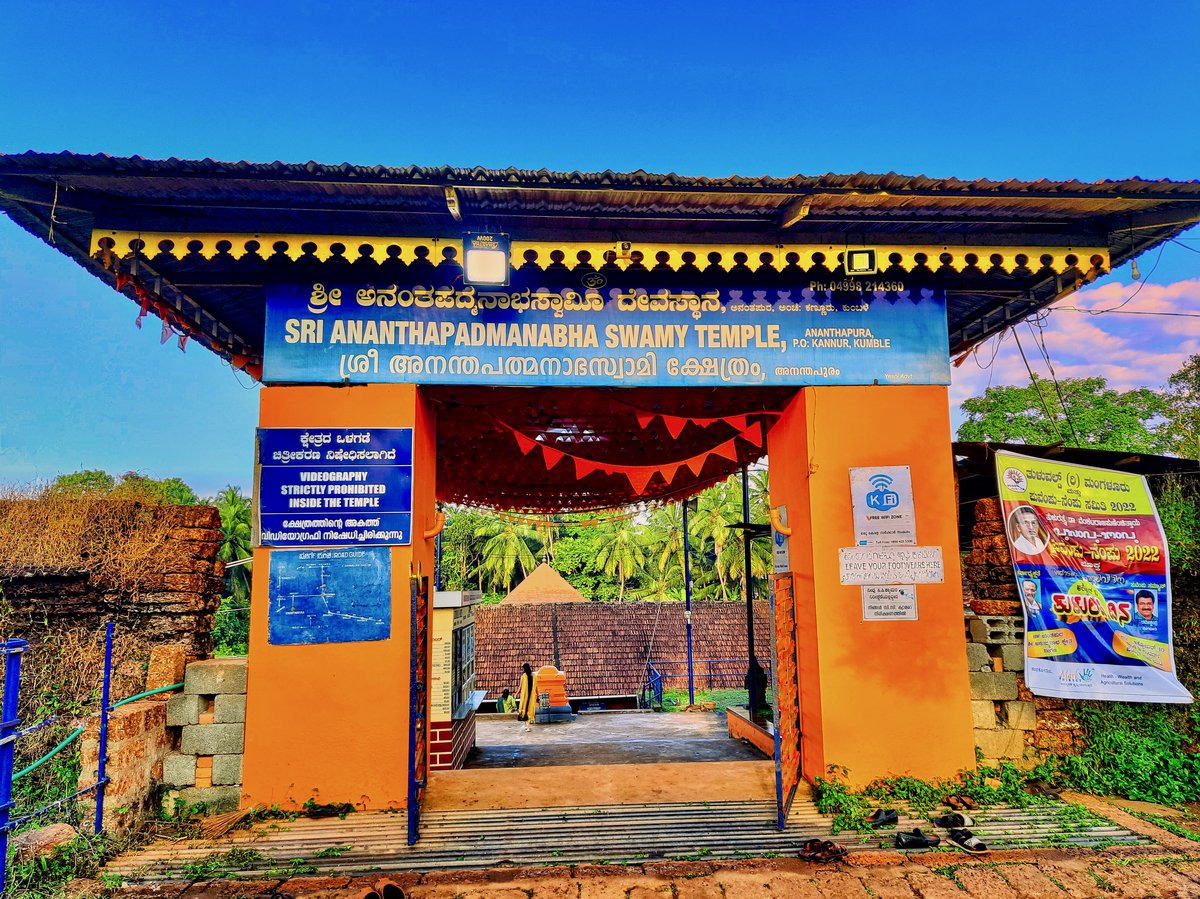
Ananthapura Temple Visiting Hours, Tickets, and Historical Sites in Kasaragod
Publication Date: 18/07/2024
Overview of Ananthapura Temple
Ananthapura Lake Temple, located in the tranquil region of Kasaragod, Kerala, is an extraordinary blend of history, architecture, and spirituality. As the only lake temple in Kerala, its construction dates back to the 9th century AD, during the reign of the Alupa dynasty. The temple’s architecture showcases a fascinating blend of Kerala and Tulunadu styles, featuring locally sourced laterite stone, intricate wood carvings, and a distinctive copper-plated shikhara. Dedicated to Lord Vishnu in his Ananthapadmanabha form, the temple is steeped in captivating legends, including the tale of a vegetarian crocodile named Babiya, believed to guard the temple pond, and the mysterious tale of the endless rice bowl. Visitors can explore this sacred site, which has been preserved and renovated over centuries, particularly during the Vijayanagara Empire’s reign in the 16th century. The temple’s serene lake setting, vibrant festivals, and nearby historical attractions like Bekal Fort and Chandragiri Fort make it a must-visit destination for pilgrims and history enthusiasts alike. (Kerala Tourism, Times of India)
Table of Contents
- Introduction
- An Architectural Marvel with Roots in the 9th Century
- Legends of Divinity and Divine Guardianship
- A Legacy Preserved - The Role of the Vijayanagara Empire
- Deity and Significance
- Visitor Information
- Festivals
- Nearby Attractions
- Travel Tips
- Conclusion
- FAQ
Exploring Ananthapura Lake Temple - History, Legends, and Visitor Information
Introduction
Ananthapura Lake Temple, nestled amidst the serene landscapes of Kasaragod, Kerala, is not just a place of worship but a treasure trove of history and legends. Its origins are shrouded in the mists of time, with various accounts painting a vivid picture of its ancient past.
An Architectural Marvel with Roots in the 9th Century
Historical evidence suggests that the temple’s construction dates back to the 9th century AD, during the reign of the powerful Alupa dynasty. The Alupas, known for their patronage of art and architecture, left an indelible mark on the region’s cultural landscape, and Ananthapura Lake Temple stands as a testament to their legacy. (Kerala Tourism)
The temple’s architectural style reflects a blend of influences, primarily from the Kerala school of architecture with subtle hints of Aryan styles. This unique fusion is evident in the temple’s intricate carvings, sloping rooflines, and the use of laterite stone, a hallmark of the region’s traditional building practices.
Legends of Divinity and Divine Guardianship
Ananthapura Lake Temple is steeped in captivating legends that have been passed down through generations, adding a mystical aura to its historical significance.
The Legend of Ananthapadmanabha
The temple is dedicated to Lord Vishnu in his form as Ananthapadmanabha, reclining on the serpent Anantha. Legend has it that the temple stands at the original site of Lord Vishnu’s divine serpent, Adishesha. This association with the serpent deity is further emphasized by the presence of a unique resident - a vegetarian crocodile named Babiya, believed to be the guardian of the temple pond. (Times of India)
The Tale of the Endless Rice
Another intriguing legend revolves around the temple’s daily rituals. It is said that during ancient times, a poor woman sought alms at the temple. The temple priest, busy with his duties, asked her to wait. However, the woman, famished and weary, could wait no longer. She cursed the temple, proclaiming that they would never have enough food from that day forward. To this day, the temple cooks prepare an offering of rice in a large bronze vessel, and strangely, the rice never seems to run out, always enough to feed all devotees and visitors. This enduring mystery adds a touch of the supernatural to the temple’s ambiance.
A Legacy Preserved - The Role of the Vijayanagara Empire
The temple’s historical journey took a significant turn during the 16th century when the Vijayanagara Empire extended its influence over the region. The Vijayanagara rulers, known for their devout Hinduism and patronage of temples, recognized the sanctity and historical importance of Ananthapura Lake Temple. They undertook extensive renovations and expansions, further enriching its architectural grandeur. The temple’s current structure, with its majestic gopuram (entrance tower), spacious mandapam (prayer hall), and intricately carved pillars, reflects the Vijayanagara influence.
Deity and Significance
The Ananthapura Lake Temple is dedicated to Lord Vishnu in his Ananthashayanam form, reclining on the serpent Adishesha. This form of Vishnu, symbolizing the universe’s creation and preservation, holds immense religious significance for Hindus.
Legend and Lore
Local legends claim that the temple marks the original site of the Kadarika Vana (forest of Kadamba trees) mentioned in the epic Mahabharata. It is believed that the Pandavas, during their exile, sought refuge in this forest and worshipped Lord Vishnu at this very spot.
The Sacred Lake
The temple’s location, in the middle of a rectangular lake, adds to its sanctity. This lake, considered sacred by devotees, is home to a unique species of vegetarian crocodiles. These crocodiles, believed to be guardians of the temple, are revered by locals and add to the mystical aura surrounding the Ananthapura Lake Temple.
Visitor Information
Visiting Hours
The temple is open to visitors from 5:30 AM to 12:30 PM and from 5:30 PM to 7:30 PM daily.
Tickets
There is no entry fee to visit the temple. However, donations are welcome.
Dress Code
As a place of worship, a strict dress code is followed at Ananthapura Lake Temple:
- Men: Are required to wear dhotis or pyjamas with their upper body bare or minimally clothed. Shirts and trousers are not permitted.
- Women: Should wear sarees, half-sarees, or churidars. It’s important to note that wearing leggings or jeans is not allowed.
Best Time to Visit
The best time to visit Ananthapura Lake Temple is during the cooler months, from October to March. The weather is pleasant during these months, making it ideal for exploring the temple and its surroundings. Avoid visiting during the monsoon season (June to September) as heavy rains can disrupt travel plans.
Getting There
The nearest major city is Kasaragod, which is well-connected by road and rail. The temple is about 12 km from Kasaragod town.
- By Air: The nearest airport is Mangalore International Airport (IXE), about 50 kilometers away. From the airport, taxis and buses are readily available to reach the temple.
- By Train: The closest railway station is Kasaragod Railway Station, around 14 kilometers from the temple. Local transportation options like taxis and buses can be used to cover the remaining distance.
- By Road: Ananthapura is well-connected by road. Kerala State Road Transport Corporation (KSRTC) buses and private buses operate frequently from Kasaragod and other nearby towns.
Where to Stay
While there are no accommodation options available within the temple premises, several hotels and homestays are available in Kasaragod town, offering a range of choices to suit different budgets.
Festivals
Ananthapura Lake Temple, with its rich history and religious significance, is known for its vibrant celebrations throughout the year. Here are some of the key festivals celebrated with great enthusiasm:
Annual Festival (March/April)
The annual temple festival, usually held in March or April, is a ten-day extravaganza that draws huge crowds. The festival features a colorful procession of the deity, accompanied by traditional music, dance performances, and elaborate rituals. The festive atmosphere during this time is truly captivating.
Maha Shivaratri (February/March)
Dedicated to Lord Shiva, Maha Shivaratri is a significant festival observed at Ananthapura Lake Temple. Devotees observe a strict fast and offer special prayers throughout the night. The temple is beautifully decorated, and the air is filled with devotional fervor.
Naga Panchami (July/August)
Naga Panchami, dedicated to the serpent deities, is celebrated with great reverence at Ananthapura Lake Temple. Special pujas and offerings are made to the serpent idols within the temple complex. It is believed that worshipping the serpent deities on this day brings prosperity and well-being.
Other Festivals
Apart from these major festivals, several other festivals are celebrated at Ananthapura Lake Temple throughout the year, including:
- Deepavali: The festival of lights is celebrated with great joy, with the temple illuminated with diyas and lamps.
- Navaratri: This nine-night festival dedicated to Goddess Durga is marked by special pujas and cultural programs.
- Vishu: The Kerala New Year is celebrated with traditional rituals and festivities at the temple.
Tips for Attending Festivals
- Plan your visit in advance, especially during major festivals, as accommodation and transportation can be fully booked.
- Be prepared for large crowds and long queues during festival days.
- Dress modestly and respectfully, adhering to the temple’s dress code.
- Be mindful of the rituals and customs followed during the festivals.
- Photography may be restricted in certain areas of the temple during festivals. It’s best to inquire beforehand.
Nearby Attractions
If you’re visiting Ananthapura Lake Temple, consider exploring these nearby attractions:
- Bekal Fort: A historical fort located about 30 km from the temple, offering stunning coastal views.
- Chandragiri Fort: Another historical site located approximately 20 km away, known for its scenic views and historical significance.
- Madhur Temple: Another ancient temple located approximately 15 kilometers away, known for its unique architecture.
Travel Tips
Accessibility
The temple is accessible to differently-abled visitors with ramps and designated areas for easy movement. Assistance is available upon request.
Guided Tours
Guided tours are available upon request and provide deeper insights into the temple’s history and legends.
Photographic Spots
The lake surrounding the temple offers picturesque views, making it perfect for photography enthusiasts. However, ensure you follow the temple’s guidelines on photography.
Conclusion
The temple’s enduring legacy lies not just in its architectural splendor or the captivating legends surrounding it, but also in its ability to transport visitors back in time, offering a glimpse into the rich tapestry of India’s past. It serves as a reminder of the enduring power of faith, the artistry of ancient builders, and the captivating allure of legends passed down through generations. (Kerala Tourism, Times of India)
FAQs
-
What are the opening hours of Ananthapura Lake Temple?
- The temple is open from 5:30 AM to 12:30 PM and from 5:30 PM to 7:30 PM daily.
-
Is there an entry fee to visit the temple?
- No, there is no entry fee, but donations are welcome.
-
Can I take a guided tour of the temple?
- Yes, guided tours are available upon request.
-
Who is Babiya?
- Babiya is the temple’s resident vegetarian crocodile, believed to be the guardian of the temple pond.
-
What is the best time to visit the temple?
- The best time to visit is during the cooler months from October to March.
Sources and Further Reading
- Exploring Ananthapura Lake Temple - History, Legends, and Visitor Information, 2023 (Kerala Tourism)
- Meet Babiya, the Vegetarian Crocodile Guarding This Ancient Temple in Kerala, 2023 (Times of India)
